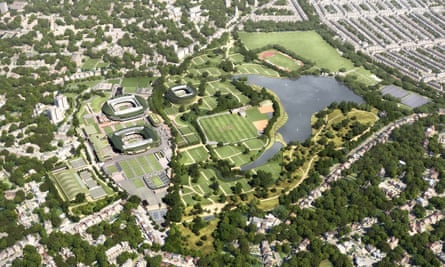“To use a tennis analogy, we’re at one-set all but we’ve got a long way to go,” says Christopher Coombe, a member of Save Wimbledon Park, as he reflects on the latest plot twist in the fight between local residents and the world’s biggest tennis tournament. “This is a five-set match with no tie-break.”
Coombe is speaking the morning after Wandsworth council unanimously rejected the All England Club’s plans to build 39 grass courts, including an 8,000-seat stadium, on the Grade II-listed Wimbledon golf club site. But last month Merton council, which has an equal say in the decision, approved the same controversial plans by 6-4. Hence the impasse – and the sense of battle lines being redrawn on the streets of Wimbledon and Southfields.
We won’t have long to wait for the next development. On Wednesday the London mayor’s office confirmed it will decide in the next fortnight whether to kill the plans entirely, or call them in for review. That decision now rests with the deputy mayor for planning, Jules Pipe, after the mayor, Sadiq Khan, recused himself because of his previous support for the expansion.
Most expect Pipe to review the project, which will delay the process for at least six months. After that, the decision could well be kicked up again to Michael Gove, the secretary of state for levelling up, and ultimately go to the courts for review. In other words, forget John Isner’s famous 11-hour marathon against Nicolas Mahut. This could be more like Bleak House’s interminable Jarndyce and Jarndyce.
The residents’ case? Broadly, they maintain that the plans to treble the All England Club in size from 41 to 115 acres will cause huge environmental damage, 10 years of disruption to the local area, and will create a huge “tennis industrial complex” – with nine kilometres of pathways, player hubs and corporate hospitality that will lie silent for much of the year.
“It would just be an absolute disaster for the environment, for biodiversity, and air quality,” says Susan Cusack of Save Wimbledon Park. “We are talking about 70 acres of metropolitan open land, with 2,000 trees and lots of species that are on the amber and red list for extinction, that will be a building site for eight to 10 years. The number of vehicles required just during the construction phase alone is 40,400.”
Cusack also dismisses suggestions of nimbyism, and says that what happens in Wimbledon will have wider ramifications. “There are 50 sites across London like this, with metropolitan open land under threat. If this case were to go through it would lay all of those areas open to development. One of the joys of London is our parks, and it would be appalling if we lost our urban greenbelt.”

However, much of that is rejected by the All England Club, which points out that its plans, which include “significant ecological enhancement works”, are supported by the London Wildlife Trust and Natural England. It has also promised to plant 1500 trees “of various ages and sizes which are much more appropriate to the landscape”, spend £6m on silting the lake in Wimbledon Park, and refurbish the children’s playground.
It also stresses other benefits to the local community, including that seven of the 39 courts will be also open to the public after the championships. The chief executive, Sally Bolton, says: “We firmly believe the Wimbledon Park project offers significant social, economic and environmental improvements, including turning 23 acres of previously private land into a new public park, alongside hundreds of jobs and tens of millions of pounds in economic benefits.”
Essentially, though, the All England Club’s argument boils down to this: it needs a third 8,000‑seat show court, along with 38 other grass courts that would largely host qualifying matches and improved practice facilities, to ensure Wimbledon remains the world’s pre-eminent tennis tournament.
That, of course, is disputed by 16,000 local residents who have now signed a petition opposing the scheme, as well as both local MPs, Labour’s Fleur Anderson and the Conservative Stephen Hammond.
As both sides wait for the next stage of the process, there seems little chance of a compromise. Instead suspicion lurks in the air, with local residents saying the All England Club has reneged on promises made in 1993 not to develop the land and in 2018 to work “in partnership with the local community”. Wimbledon deny this and point out that 5,000 residents have attended one of their consultation events.
“The way they are proceeding is a big sport thinking it has so much money it can do what it likes,” says Jonathon Norrish. “My message to them is simple: the scale of the development is too much. So bring the community more into the process and let’s start again.”
Whatever happens next, one thing is already clear: few matches in the All England Club’s 146-year history have been as prolonged or fractious.

